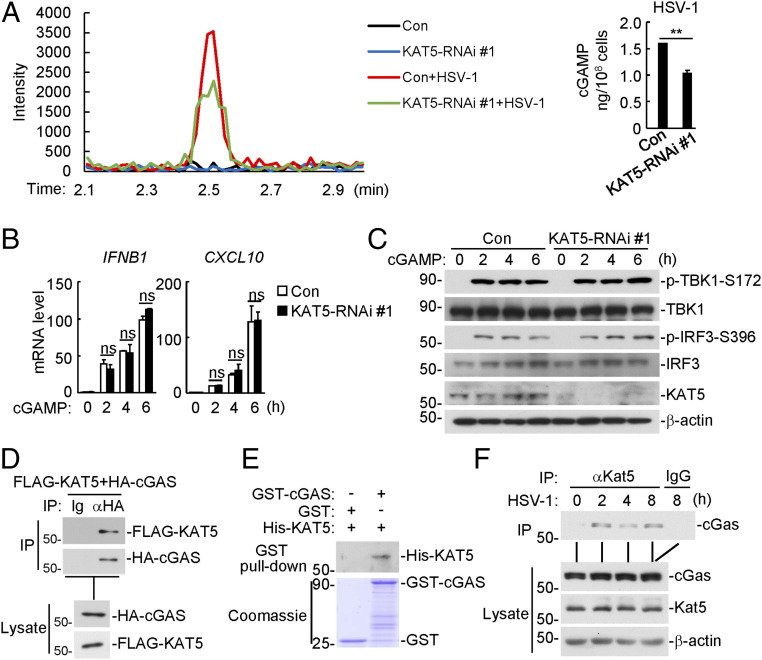Fig. 2.
KAT5 functions at the cGAS level. (A) Effects of KAT5 knockdown on cGAMP synthesis induced by HSV-1 infection. The KAT5-knockdown and control THP-1 cells (1 × 108) were left uninfected or infected with HSV-1 (MOI = 2) for 3 h, and then the cell extracts containing cGAMP were separated by chromatography using a C18 column. The abundance of cGAMP was quantitated by mass spectrometry. Quantification of cGAMP was shown in the histograph (Right). **P < 0.01 (unpaired t test). Data shown are mean ± SD of three technical repeats. (B) Effects of KAT5 knockdown on cGAMP-induced transcription of downstream genes. The KAT5-knockdown and control THP-1 cells were left untreated or treated with 2′3′-cGAMP (40 nM) for the indicated times before qPCR analysis. ns, no significance (unpaired t test). Data shown are mean ± SD from one representative experiment performed in triplicate. (C) Effects of KAT5 knockdown on cGAMP-induced phosphorylation of TBK1-S172 and IRF3-S396. The KAT5-knockdown and control THP-1 cells were left untreated or treated with 2′3′-cGAMP (40 nM) for the indicated times before immunoblotting analysis with the indicated antibodies. (D) Interaction of KAT5 and cGAS in mammalian overexpression system. HEK293 cells were transfected with the indicated plasmids for 20 h. Cell lysates were immunoprecipitated with control IgG or anti-HA. The lysates and immunoprecipitates were subjected to immunoblotting analysis with the indicated antibodies. (E) Interaction of KAT5 and cGAS in vitro. GST, GST-cGAS, and His-KAT5 proteins were purified from Escherichia coli. Recombinant GST or GST-cGAS was mixed with His-KAT5. The GST or GST-cGAS protein was pulled down with glutathione Sepharose beads and then analyzed by immunoblotting with the indicated antibodies. (F) Association of endogenous KAT5 with cGAS. The mouse lung fibroblasts were left uninfected or infected with HSV-1 (MOI = 1) for the indicted times before cells were harvested for immunoprecipitation with control IgG or anti-KAT5. The lysates and immunoprecipitates were subjected to immunoblotting analysis with the indicated antibodies.

